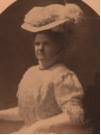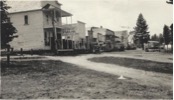12/17/14 – First Ladies of Idaho
December 17, 2014Here’s a neat find from a recent trip to the archives: a booklet of photos and autobiographies of the first ladies of Idaho.[i] The booklet was published by the Friends of the Historical Museum in 1990, and it offers a glimpse into the lives (and wardrobes) of the wives of Idaho’s first governors. The early first ladies of Idaho were musicians and artists, college graduates, mothers to as many as eight children, and members of pioneering families that crossed the country decades before Idaho was even a state. One was born in a log cabin, one worked for the Works Progress Administration, many grew up on rural Idaho ranches, and too many suffered the loss of young children. Several moved to Washington D.C. when their husbands became U.S. Senators, or, in the case of Nellie Davis nee Johnson, when her husband D.W. Davis became supervisor of the United States Reclamation Service (which was clearly during the early 1920s, if her dress is anything to go by).
Louise McConnell nee Brown, the second woman in the booklet, crossed the plains from Ohio to the Willamette Valley of Oregon with her family in 1852, when she was six. Her husband served as the third governor of the new State of Idaho and later as a U.S Senator, but Louise stayed put in Moscow and must have seen an amazing amount of change as the region developed around her.
From rural farmwife to socialite, it’s hard to find a greater contrast in this booklet than that between Louise and Amanda Gooding nee Thomas, wife of Governor and then Senator Frank Gooding. The Goodings moved to Idaho from California in 1880 and were prominent in the local social scene, where, the booklet tells us, Amanda was known as a “woman of excellent sense and discretion and a fine hostess.” Clearly, she was also a woman of large hats.
One of the most interesting tidbits in the booklet was the revelation that one first lady, Mary Elizabeth Hawley nee Bullock, lived in what is now a ghost town. Quartzburg, Idaho, located due south of Garden Valley, was once a booming mining town, leading the mining transition from gold to quartz. In the 1870s, the town was home to the Hawleys before they moved to Idaho City and later to Boise . . . and before Quartzburg was destroyed by a fire in 1931.
Without a doubt, the winner of the best headdress in the booklet goes to Mary Haines nee Symons and her feathers. Mary’s favorite thing about Boise, when she moved here from Kansas in the early 1890s, was the abundance of local fresh fruit and vegetables, something that certainly still rings true today.
The history of Idaho’s early first ladies encapsulates the early history of Idaho itself: pioneer settlement, mining, farming, and a slow development into the state it is today.
– Naomi Heindel
Editor’s Note: From time to time, SHRA comes across fun, interesting and notable items in the archives that we think would be of interest to our readers but that don’t warrant a longer blog post. This piece is one of a series of vignettes that we hope will bring some of these discoveries to life. If you’re looking for one of our longer pieces, click on “Features” under “Categories” in the left navigation column.
_____________________________________________________________________________
[i] “First Ladies of Idaho,” Friends of the Historical Museum, Boise, Idaho, 1990
[ii] “Quartzburg, Idaho c. 1924,” via www.ancientfaces.com





